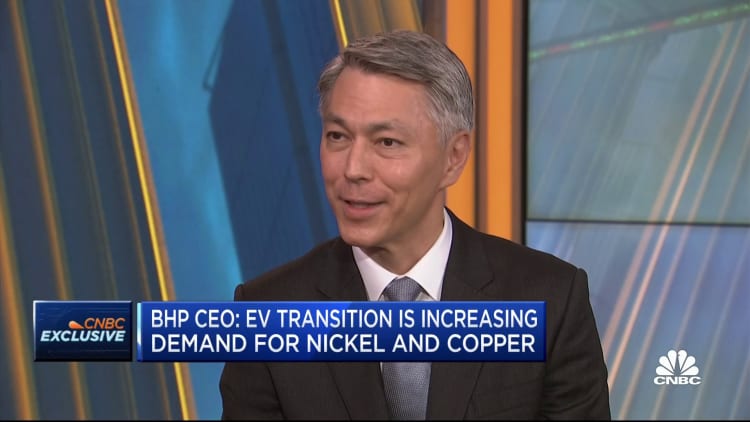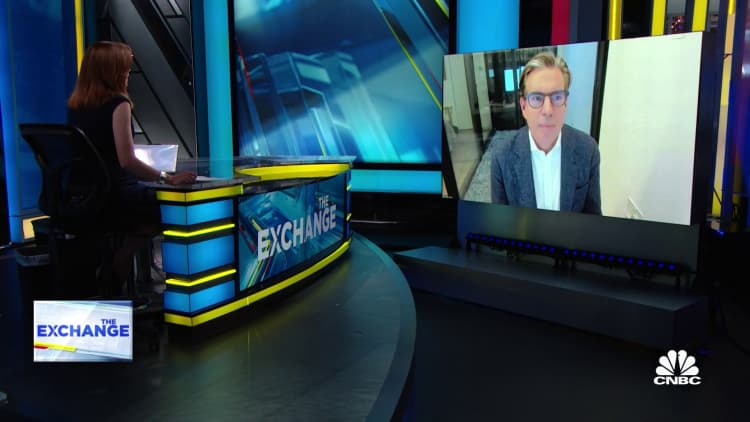
A worker in heat resistant protective clothing supervises the liquid copper mold production line at the KGHM Polska Miedz SA smelting plant in Glogow, Poland, on Tuesday, March 9, 2021.
Bloomberg | Bloomberg | Getty Images
Doctor Copper, the nickname for the ubiquitous red metal that historically has taken the pulse of the global economy, is currently busy diagnosing the health of the clean energy transition. Naturally conductive copper is one of the critical minerals — along with lithium, cobalt and nickel — in the manufacturing of electric vehicles, EV batteries, solar panels, wind turbines and the power grids that connect renewable sources to homes and businesses. Yet the prognosis for the industry to supply enough copper to meet that rapidly growing demand is not particularly rosy.
Recent reports from S&P Global, Wood Mackenzie, the International Energy Agency and other researchers conclude that while demand for copper could nearly double by 2035, mining companies are having a hard time keeping up. That shortfall threatens to not only hamper growth in clean energy but also short-circuit the goal of net-zero emissions by 2050, the benchmark in staving off climate change calamity. Solutions to the problem include improving existing mining operations, developing novel extraction technologies, and stepping up recycling efforts.
At the same time, because copper reserves are finite, the industry “needs investment to continue and decisions to be made on [new] extraction projects in order to meet future growth,” said Nick Pickens, research director of global mining at Wood Mackenzie. “Despite the fact that we’ve had pretty high copper prices over the last year or two, we’re not seeing the rate of sanctioning [of new projects] needed to fill that supply gap,” he said.

In the meantime, copper customers, in anticipation of shortages, are either delaying clean energy projects or reducing their need for copper, an economic principle known as demand destruction. For example, higher costs for materials including copper and supply chain snags have slowed the growth in offshore wind projects. Engineering innovations are allowing Tesla and other EV makers to reduce the amount copper in their vehicles and batteries.
Politics might also play a role in demand destruction for copper. A group of conservative organizations led by the Heritage Foundation, eyeing a Republican victory in the 2024 presidential election, have drawn up Project 2025. Among other actions, it would dismantle most of the clean energy projects initiated by the Biden Administration. And on September 20, U.K. Prime Minister Rishi Sunak cut back many of Britain’s commitments to mitigate climate change, including a delay in banning sales of new vehicles powered by gas or diesel to 2035 from 2030, impacting the auto industry’s deep investments in EVs.
A ‘striking’ lack of copper production and new era of demand
Richard Adkerson joined Phoenix-based Freeport-McMoRan, one of world’s largest copper mining companies, in 1989 and became CEO 20 years ago. During that span, he’s witnessed the cyclical nature of copper tied to the ups and downs in the world economy. “Copper was the commodity most closely correlated to industrial production,” he said. “When business cycles would turn up, copper inventories would fall and prices would go up. Resources were known to exist, investment would occur, inventories would build and prices came down.”
Around the time Adkerson took the reins at Freeport, China was emerging as an industrial superpower and dominant consumer of copper for its burgeoning solar, wind and EV industries, adding “a whole new dimension to demand that wasn’t there previously,” he said. At that point, the consensus was that there would be a major copper supply response. Instead, what Adkerson found “was that the resources simply weren’t there,” he said. “It is striking as to how little copper has been developed [globally] over the past 20 years.”
That’s presented the industry with a whole new era of copper demand, Adkerson said. China’s economy has slowed, while those in the U.S. and Europe are striving to transition to clean energy. Then, on the supply side, there’s lackluster investment in mining projects, driven by inflation, higher interest rates, the situation in China and geopolitical turmoil. “This ultimately is building up to a view, which I share with others, of a looming shortage,” Adkerson said.
Freeport security personnel look on at the Freeport McMoRan’s Grasberg mining complex, one of the world’s biggest gold and copper mines located in Indonesia’s remote eastern Papua province. Freeport’s Indonesia operations reported production of 3 million tons of copper concentrate in 2022, an annual record.
Afp | Afp | Getty Images
A major factor in copper supply is the long lead time for establishing new mining projects, a reality inherent to mining companies’ investment strategies. “Mining is a long-term business,” said Clayton Walker, COO of Rio Tinto Copper, in an email. “Bringing a new greenfield project online can take decades.” He cited the company’s large copper mine in Mongolia, which he wrote achieved sustainable underground production this year after more than 20 years of exploration and development.
Planning for such long lag times comes down to copper miners de-risking their balance sheets, said Matt Murphy, a mining industry analyst at Barclays. “They want to optimize their capital expenditure schedules to make sure they don’t have a pinch point where they’re spending way beyond their operating cashflow and levering up too far.”
Those time horizons can also be an eternity for outside investors looking for short-term returns. “If a company says they’re going to build a project, there will be certain investors who just avoid investing until the project’s been de-risked,” Murphy said. “I think that’s why we haven’t seen capital flowing into new supply.”
How metals miners are planning for the future
On the other hand, to meet the present and expected demand for copper, companies are focusing on getting the most out of their existing, or brownfield, assets. Walker pointed to recently announced investments totaling close to $1 billion to expand underground mining, rebuild a smelter and make improvements to its refinery at the Rio Tinto Kennecott copper operation near Salt Lake City, Utah. Kennecott is a 120-year-old operation that supplies roughly 12% of U.S. copper demand.
Rio Tinto, Freeport and other mining companies are also working on a technology known as leaching, which allows them to recover copper from low-grade sulfide deposits that may not have been commercially viable in the past. “Leaching has very limited capital requirements, the operating costs are low, there are no carbon emissions and generally no permitting required, which are all big parts of traditional mining,” Adkerson said.
Another supply-side innovation is automating and electrifying operations, which beyond initial capex, can reduce skilled labor costs, improve safety and efficiency and help miners hit their own net-zero goals. Freeport has introduced robotics at its Grasberg underground mine in Indonesia and is working with Caterpillar on giant battery-electric haul trucks, a piece of Caterpillar’s ambitious plans to ultimately have autonomous industrial vehicles on the moon. At its Kennecott operation, Rio Tinto is trialing electric trucks, as well ones powered by renewable diesel.

Recycling of scrap copper from end-of-life products will be key as well. Recycled copper accounted for about 32% of copper demand during the last decade, according to the International Copper Association. That number is expected to grow as, coincidentally, clean energy components such as EV batteries, solar panels and wind turbines reach their end of life and are recycled instead of ending up in landfills. “You can reuse copper indefinitely without losing conductivity,” Pickens said. “Our expectation is that the proportion of scrap use will grow over the long term up to 45-50% of the [copper] market.”
Even if predictions pan out and mining companies have trouble meeting near-term demand for copper, the transition to clean energy is inevitable, as is the critical need for copper. “We predict over 25% of copper consumption in 2050 will likely be attributable to the additional demand associated with a transition to net zero,” Walker said.
Pickens echoed that sentiment. “Copper has a huge part to play in the energy transition,” he said. “We need it, it’s going to be there and there’s a great story for it. Fundamentally, copper is a necessity for powering the future.”
